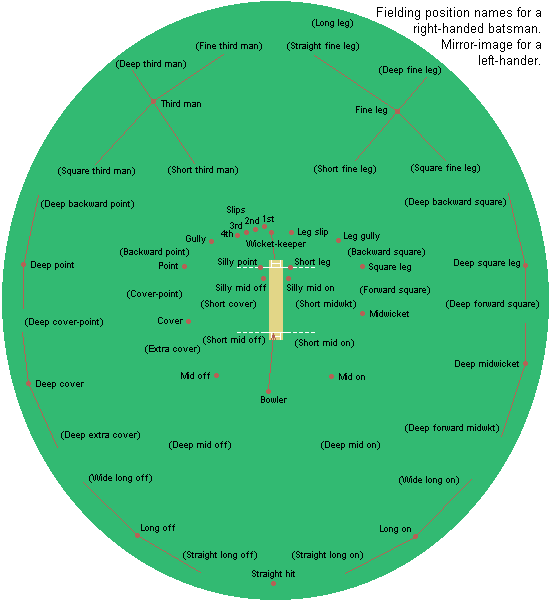Fielding Positions
|
In baseball, fielders stand in standardised regions and each fielding location has a single name.
In cricket, the fielding captain moves fielders to differently named positions based on tactics.
|
The fielding captain instructs his fielders where they should field. There are dozens of differently named fielding
positions, not all of which can be filled by the players. The captain selects a combination of fielding positions designed
to fit with his tactics.
 The fielding positions shown here with a brown dot are the basic named positions. Names in parentheses indicate variations.
Any position on the field can be described by combining standard names with various adjectives:
The fielding positions shown here with a brown dot are the basic named positions. Names in parentheses indicate variations.
Any position on the field can be described by combining standard names with various adjectives:
- Silly: Very close in to the batsman.
- Short: Closer in towards the batsman.
- Deep: Further out towards the boundary.
- Long: Right near the boundary.
- Forward: Further in front of the batsman's popping crease.
- Backward: Further behind the batsman's popping crease.
- Fine: Closer to the line bisecting off and leg sides.
- Straight: A synonym for fine.
- Wide: Further from the line bisecting off and leg sides.
- Square: Closer to the line of the batsman's popping crease.
Note that the positions shown are for a right-handed batsman. For a left-handed batsman, the off and leg sides are reversed,
as are all the fielding positions.
The slips, gully, short leg, and "silly" positions are close catching positions, designed almost purely to take catches
that the batsman inadvertantly hits with his bat. Fielders in these positions stand crouched slightly with bent knees
and their hands cupped in front of them ready to take a catch.
Fielders in other positions are more run-saving positions. These fielders will stand upright and usually walk in slowly
a few paces as the bowler bowls the ball, to give them a bit of momentum so that they can move to chase and gather the
ball quickly if it goes in their direction.

Typical field setting for a fast bowler (walking back to his bowling mark)
|
The Wicket-Keeper
|
In baseball, first base and right field are always to the left of the pitcher.
In cricket, point and mid off are to the left of the bowler if he is bowling to a right-handed batsman, but to his right if bowling to a left-handed batsman.
|
|
In baseball, the catcher stands right behind the batter.
In cricket, the wicket-keeper only stands close to the batsman if a slow bowler is bowling. For a fast bowler he stands much further back.
|
The wicket-keeper stands behind the striker's wicket, ready to catch the ball if the batsman misses it.
- For a fast bowler, the wicket-keeper stands back 15-20m (50-65 feet) behind the wicket, so that he usually catches
the ball on its downward arc after it has bounced on the pitch and passed the batsman. This also gives him time to see
small deviations if the batsman hits the ball with the edge of his bat, so he can react in time to catch them.
- For a slow bowler, the wicket-keeper stands right behind the wicket, within arm's length of it. This allows him to
catch the ball quickly and hit the wicket with it if the batsman steps outside his popping crease while playing a missed shot,
thus stumping the batsman out.
Either way, the wicket-keeper does not stand directly behind the wicket, but slightly to the off side. This allows the
wicket-keeper to see past the batsman to the bowler, and places him best to catch most balls, as most commonly balls pass
outside the off stump.
Home | DM's Explanation of Cricket
Last updated: Saturday, 17 February, 2007; 15:18:10 PST.
Copyright © 1990-2022, David Morgan-Mar. dmm@dangermouse.net
Hosted by: DreamHost
 The fielding positions shown here with a brown dot are the basic named positions. Names in parentheses indicate variations.
Any position on the field can be described by combining standard names with various adjectives:
The fielding positions shown here with a brown dot are the basic named positions. Names in parentheses indicate variations.
Any position on the field can be described by combining standard names with various adjectives:
 The fielding positions shown here with a brown dot are the basic named positions. Names in parentheses indicate variations.
Any position on the field can be described by combining standard names with various adjectives:
The fielding positions shown here with a brown dot are the basic named positions. Names in parentheses indicate variations.
Any position on the field can be described by combining standard names with various adjectives:
